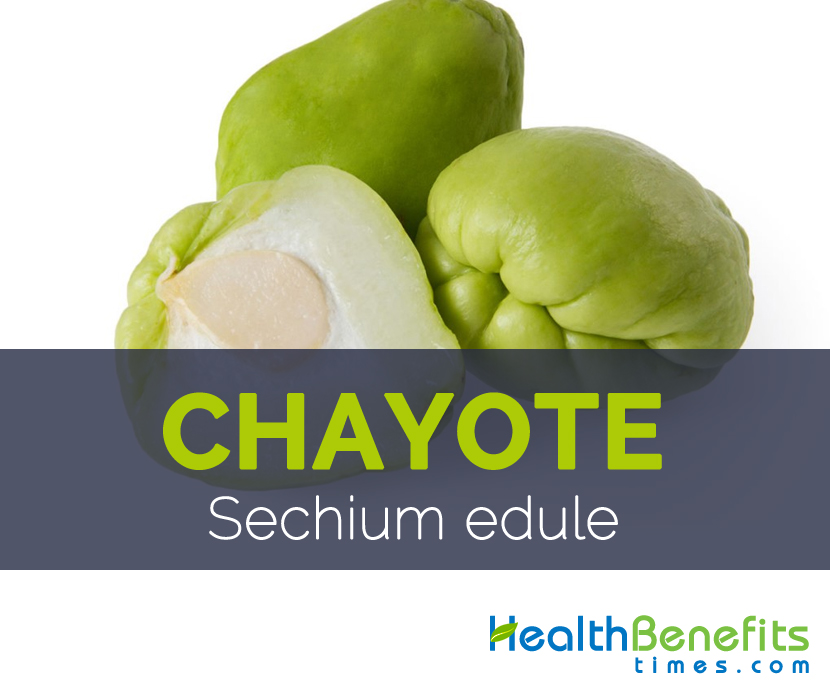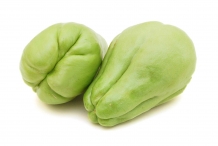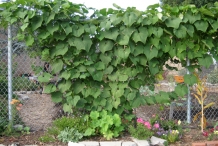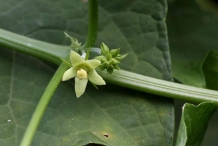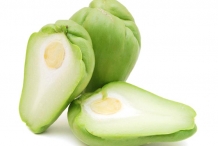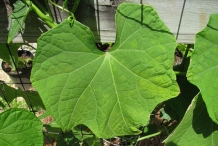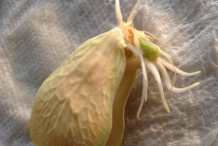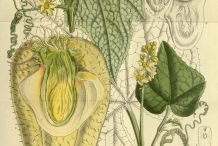It was first domesticated by the Aztecs and Mayas in pre-Columbian times. This plant is a member of the Cucurbitaceae family and is mainly produced as a non-traditional export crop. Because of the wide diversity of chayote plants found in Mexico (predominantly the states of Veracruz, Puebla, Chiapas, and Oaxaca) and in Guatemala, this region is thought to be their geographic origin. Today, chayote is cultivated through tropical and subtropical regions of the world. The neutral flavor and softness of chayote fruit make it particularly suitable for the food industries. Although chayote is mainly used for culinary purposes, the taste may vary depending on the strain and use. Additionally, the stems, leaves, and tuberous sections of the adventitious roots are also commonly consumed and are of nutritional relevance as food and feed.
Plant
Chayote is a perennial, monoecious climbing vine sized 12 meters or more when support is provided. It is found growing in cool climate, with full sun and moderate rainfall and prefers well-drained, moist, deep, fertile soil rich in organic matter however waterlogged, clayey soil or sandy soil must be avoided. At their natural habitat, mirlitons run along fences, over shrubs, and even on straight-up trees. In the cultivated farms, the crop is supported with strong trellis. It has thickened tuberous roots with brown skin and white inside. Stem are usually slender, branching, grooved angular stems and 3–5 fid tendrils. Leaves are 7 to 25 cm wide broadly ovate, angled, or slightly lobed and cordate (heart-shaped) at the base and apiculate (tapered) towards the apex. The petiole is 3 to 15 cm long. Leaves look like those of cucumber. Flower are small, greenish-white, unisexual, normally pentamerous, coaxillary and with ten nectaries in the form of a pore at the base of the calyx. Axillary racemose inflorescences are 10–30 cm long, with patteliform calyx consisting of 5 triangular sepals, 5 triangular petals and 5 stamens.
Fruit
Chayote is a roughly pear-shaped, slightly flattened and with rough wrinkles, ranging from 10 to 20 cm in length and 7–12 cm wide vegetable which weighs about 100-900 gram. It has thin white and yellowish, or pale green to dark green or brown color skin and several shallow vertical furrows on the surface. Some varieties have spiky or fuzzy surface while others have smooth skin. Flesh is usually pale green to whitish colored. The flesh of the chayote is mild in flavor and has a texture somewhere between a potato and cucumber. It has a mild sweet taste that is similar to butternut squash or pumpkin. Seed is cream-white colored ovoid and compressed with a soft and smooth testa and often germinates within the fruit and has nutty flavor. Chayote is usually harvested from September through May. Almost all parts (seeds, roots, shoots, flowers, leaves and fruit) can be consumed raw, steamed, boiled, fried or even marinated to get healthy and delicious delicacies.
History
Chayote also known as Choko is found wild in the cool mountains of Central America exactly where it was first domesticated by the Aztecs. South Mexico and Guatemala are the center of greatest diversity of the cultivated chayote and the most likely center of origin for this ancient crop. Today, chayote is cultivated all through the tropical (highlands) as well as subtropical world for the edible fruits and tubers.
Nutritional Value
Apart from their mild sweet taste Chayote is a good source of nutrients, vitamins and minerals. Consuming 160 gram of chayote offers 0.176 mg of Copper, 0.189 mg of Vitamin B6, 12.8 mg of Vitamin C, 0.653 mg of Vitamin B5, 4.5 g of Total dietary Fiber and 0.27 mg of Manganese. Moreover many Amino acids like 0.013 g of Tryptophan, 0.05 g of Threonine, 0.053 g of Isoleucine, 0.093 g of Leucine and 0.048 g of Lysine are also found in 160 gram of the Chayote.
Calories 38 Kcal. Calories from Fat 6.93 Kcal.
| Chayote Quick Facts | |
|---|---|
| Name: | Chayote |
| Scientific Name: | Sechium edule |
| Origin | Central America |
| Colors | Pale green to dark green or brown |
| Shapes | Roughly pear-shaped, somewhat flattened and with coarse wrinkles, ranging from 10 to 20 cm in length and 7–12 cm wide |
| Flesh colors | Pale green to whitish |
| Taste | Mild sweet taste |
| Calories | 38 Kcal./cup |
| Major nutrients | Copper (19.56%) Vitamin B6 (14.54%) Vitamin C (14.22%) Vitamin B5 (13.06%) Total dietary Fiber(11.84%) |
| Proximity | Amount | % DV |
|---|---|---|
| Water | 149.49 g | N/D |
| Energy | 38 Kcal | N/D |
| Energy | 160 kJ | N/D |
| Protein | 0.99 g | 1.98% |
| Total Fat (lipid) | 0.77 g | 2.20% |
| Ash | 0.61 g | N/D |
| Carbohydrate | 8.14 g | 6.26% |
| Total dietary Fiber | 4.5 g | 11.84% |
| Total Sugars | 3.02 g | N/D |
| Minerals | Amount | % DV |
|---|---|---|
| Calcium, Ca | 21 mg | 2.10% |
| Iron, Fe | 0.35 mg | 4.38% |
| Magnesium, Mg | 19 mg | 4.52% |
| Phosphorus, P | 46 mg | 6.57% |
| Potassium, K | 277 mg | 5.89% |
| Sodium, Na | 2 mg | 0.13% |
| Zinc, Zn | 0.5 mg | 4.55% |
| Copper, Cu | 0.176 mg | 19.56% |
| Manganese, Mn | 0.27 mg | 11.74% |
| Selenium, Se | 0.5 µg | 0.91% |
| Vitamins | Amount | % DV |
|---|---|---|
| Water soluble Vitamins | ||
| Vitamin B1 (Thiamin) | 0.042 mg | 3.50% |
| Vitamin B2 (Riboflavin) | 0.064 mg | 4.92% |
| Vitamin B3 (Niacin) | 0.672 mg | 4.20% |
| Vitamin B5 (Pantothenic acid) | 0.653 mg | 13.06% |
| Vitamin B6 (Pyridoxine) | 0.189 mg | 14.54% |
| Vitamin B9 (Folate, Folic acid) | 29 µg | 7.25% |
| Folate, DEF | 29 µg | N/D |
| Choline | 16.8 mg | 3.05% |
| Vitamin C (Ascorbic acid) | 12.8 mg | 14.22% |
| Fat soluble Vitamins | ||
| Vitamin E (alpha-tocopherol) | 0.22 mg | 1.47% |
| Vitamin K (phylloquinone) | 7.5 µg | 6.25% |
| Amino Acids | Amount | % DV |
|---|---|---|
| Tryptophan | 0.013 g | 2.95% |
| Threonine | 0.05 g | 2.84% |
| Isoleucine | 0.053 g | 3.17% |
| Leucine | 0.093 g | 2.52% |
| Lysine | 0.048 g | 1.44% |
| Methionine | 0.002 g | N/D |
| Phenylalanine | 0.058 g | N/D |
| Tyrosine | 0.038 g | N/D |
| Valine | 0.075 g | 3.55% |
| Arginine | 0.042 g | N/D |
| Histidine | 0.018 g | 1.46% |
| Alanine | 0.061 g | N/D |
| Aspartic acid | 0.11 g | N/D |
| Glutamic acid | 0.15 g | N/D |
| Glycine | 0.05 g | N/D |
| Proline | 0.053 g | N/D |
| Serine | 0.056 g | N/D |


